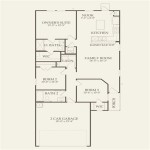One Story Low Country House Plans: A Comprehensive Overview
Low Country architecture, with its distinctive characteristics, has long been celebrated for its functionality and aesthetic appeal. Rooted in the coastal regions of the Southeastern United States, particularly South Carolina and Georgia, this architectural style is well-suited to the humid climate and flat terrain of the area. One story Low Country house plans offer a compelling blend of comfort, practicality, and timeless elegance, making them a popular choice for homeowners seeking a relaxed and refined lifestyle.
The essence of Low Country architecture lies in its adaptability to the environment. These homes are designed to maximize natural light and ventilation, while also providing protection from the elements. The emphasis on outdoor living spaces further enhances the connection with the surrounding landscape. Understanding the defining features and considerations of one story Low Country house plans is crucial for anyone considering building or renovating a home in this style.
Key Features of One Story Low Country House Plans
One story Low Country house plans are distinguished by several key features that contribute to their overall charm and functionality. These features are not merely aesthetic; they are deeply rooted in the practical needs of the region and its climate.
Elevated Foundations: One of the most recognizable characteristics of Low Country homes is the elevated foundation. This elevation serves several purposes. Primarily, it protects the home from flooding, which is a common concern in coastal areas. The elevated foundation also allows for better ventilation beneath the house, helping to mitigate moisture and prevent rot. In some cases, the space beneath the house can be used for storage or even converted into a finished living area, depending on local building codes and regulations.
The elevation is typically achieved through the use of brick or concrete piers, creating a crawl space beneath the structure. The visible foundation adds to the visual appeal of the home, giving it a sense of permanence and stability. The landscaping around the foundation often incorporates native plants and materials, further integrating the home with its surroundings.
Wide Porches: Expansive porches are another defining feature of Low Country architecture. These porches are not just decorative elements; they are integral to the lifestyle associated with the region. They provide shaded outdoor spaces for relaxation, entertaining, and enjoying the surrounding views. The deep overhang of the porch roof helps to protect the interior of the home from direct sunlight, reducing the need for air conditioning and contributing to energy efficiency.
Porches are typically designed to wrap around at least one, if not several, sides of the house, maximizing the available outdoor living space. Wicker furniture, rocking chairs, and ceiling fans are common additions, creating a comfortable and inviting atmosphere. The porch often serves as an extension of the living room, blurring the lines between indoors and outdoors.
Simple Rooflines: Low Country homes typically feature simple rooflines, often with a low pitch. This design helps to minimize the impact of strong winds and hurricanes, which are a common threat in coastal areas. Gable or hip roofs are the most common choices, and they are often clad in materials such as asphalt shingles, metal roofing, or wood shakes.
The simplicity of the roofline also contributes to the overall aesthetic of the home, creating a clean and understated appearance. Dormers may be added to provide additional light and ventilation to the attic space, but they are typically kept to a minimum to maintain the simplicity of the roof design. Gutters and downspouts are essential components, directing rainwater away from the foundation and preventing erosion.
Abundant Windows and Doors: Natural light and ventilation are crucial elements of Low Country house design. Large windows and doors are strategically placed to maximize the flow of air and light throughout the home. Transom windows above the doors are a common feature, allowing for additional light while maintaining privacy. The use of hurricane-resistant windows and doors is essential in coastal areas to protect the home from severe weather.
French doors are often used to connect the interior spaces with the porches, creating a seamless transition between indoors and outdoors. The placement of windows and doors is carefully considered to take advantage of prevailing breezes and minimize the need for artificial lighting. The use of light-colored window treatments can further enhance the diffusion of natural light throughout the home.
Materials: The materials used in Low Country homes are typically durable and weather-resistant. Wood siding, such as clapboard or board-and-batten, is a common choice, and it is often painted in light colors to reflect sunlight and reduce heat absorption. Brick is also frequently used, especially for foundations and chimneys. The use of natural materials, such as wood and stone, helps to create a sense of warmth and authenticity.
Interior materials often include hardwood floors, wainscoting, and exposed beams. These elements add to the overall character of the home and create a sense of timeless elegance. The use of durable and low-maintenance materials is essential to ensure the longevity of the home and minimize the need for repairs.
Advantages of One Story Low Country House Plans
Choosing a one story Low Country house plan offers several advantages, especially for homeowners who prioritize accessibility, convenience, and a connection with the surrounding landscape.
Accessibility: One of the most significant advantages of a one story home is its accessibility. With no stairs to navigate, the home is easily accessible for people of all ages and abilities. This is particularly important for elderly individuals or those with mobility limitations. A one story layout also makes it easier to move furniture and other large items throughout the home.
The absence of stairs also reduces the risk of falls, making the home a safer environment for families with young children. The open floor plans that are common in Low Country homes further enhance accessibility, allowing for easy movement between rooms.
Ease of Maintenance: One story homes are generally easier to maintain than multi-story homes. Exterior maintenance, such as painting and gutter cleaning, is simplified by the lack of height. Interior maintenance is also made easier by the single-level layout, eliminating the need to carry cleaning supplies and equipment up and down stairs.
The simplicity of the roofline also contributes to ease of maintenance, as there are fewer complex angles and surfaces to worry about. The use of durable and low-maintenance materials further reduces the need for repairs and upkeep.
Connection with the Outdoors: Low Country architecture emphasizes the connection with the surrounding landscape, and one story homes are particularly well-suited to this. The expansive porches and abundant windows create a seamless transition between indoors and outdoors, allowing homeowners to enjoy the natural beauty of their surroundings.
The single-level layout makes it easier to access the yard and garden, fostering a closer connection with nature. The design often incorporates outdoor living spaces, such as patios and decks, further enhancing the connection with the outdoors. The emphasis on natural light and ventilation also contributes to a healthier and more comfortable living environment.
Energy Efficiency: One story homes can be more energy-efficient than multi-story homes, particularly in warm climates. The low-pitched roof and wide porches help to shade the interior of the home, reducing the need for air conditioning. The abundant windows and doors allow for natural ventilation, further reducing energy consumption.
The single-level layout also minimizes heat loss in the winter, as there are fewer exterior walls and less surface area to radiate heat. The use of energy-efficient windows, insulation, and appliances can further enhance the energy efficiency of the home.
Considerations for One Story Low Country House Plans
While one story Low Country house plans offer numerous advantages, there are also several considerations to keep in mind when planning and designing such a home.
Land Requirements: One story homes typically require more land than multi-story homes of similar square footage. This is because the footprint of the home is larger, requiring a larger lot to accommodate the structure and surrounding landscaping. Homeowners need to ensure that they have sufficient land to accommodate their desired home size and layout.
The shape and topography of the land can also influence the design of the home. Irregularly shaped lots may require custom plans and designs. Sloping lots may require additional site preparation and grading. It is important to consult with an experienced architect or builder to assess the suitability of the land for a one story Low Country home.
Privacy: In some cases, one story homes may offer less privacy than multi-story homes, particularly in densely populated areas. With all of the living spaces on a single level, it may be more difficult to create private retreats within the home. Strategic placement of windows and landscaping can help to mitigate this issue.
The use of window treatments, such as blinds or curtains, can also provide additional privacy. The design of the home can incorporate features such as courtyards or walled gardens to create private outdoor spaces. Careful consideration of the orientation of the home on the lot can also help to maximize privacy.
Cost: The cost of building a one story Low Country home can vary depending on several factors, including the size of the home, the materials used, and the complexity of the design. In some cases, one story homes may be more expensive to build than multi-story homes of similar square footage, due to the larger foundation and roof area.
However, the long-term maintenance costs of a one story home are typically lower, due to the ease of maintenance and reduced energy consumption. It is important to develop a detailed budget and obtain multiple bids from qualified contractors to ensure that the project stays within budget.
Resale Value: The resale value of a one story Low Country home can be influenced by several factors, including the location of the home, the quality of the construction, and the overall condition of the property. In some markets, one story homes may be more desirable than multi-story homes, particularly among older buyers or those with mobility limitations.
The unique architectural characteristics of Low Country homes can also enhance their resale value, as they are often seen as charming and desirable. It is important to research the local real estate market and consult with a real estate professional to understand the potential resale value of a one story Low Country home in a particular area.

Low Country House Plans Floor Designs Houseplans Com

Low Cost Single Story 4 Bedroom House Floor Plans Country Farm 2200 Sf Basement One

Low Country Style Single Story House Plans Bungalow Craftsman

Plan W15035nc Narrow Lot Low Country Cottage Vacation Beach Photo Gallery House Plans Home Floor Layout

Our Best Tiny Country House Plans And Small Designs

Plan 765022twn Beautiful Low Country Home With Detached Garage Homes House Plans Farmhouse

10 Small House Plans With Open Floor Blog Homeplans Com

One Story House Plans Single Floor Design

Plan 765022twn Beautiful Low Country Home With Detached Garage Homes Plans House

These Small House Plans Pack A Lot Of Punch Houseplans Blog Com








